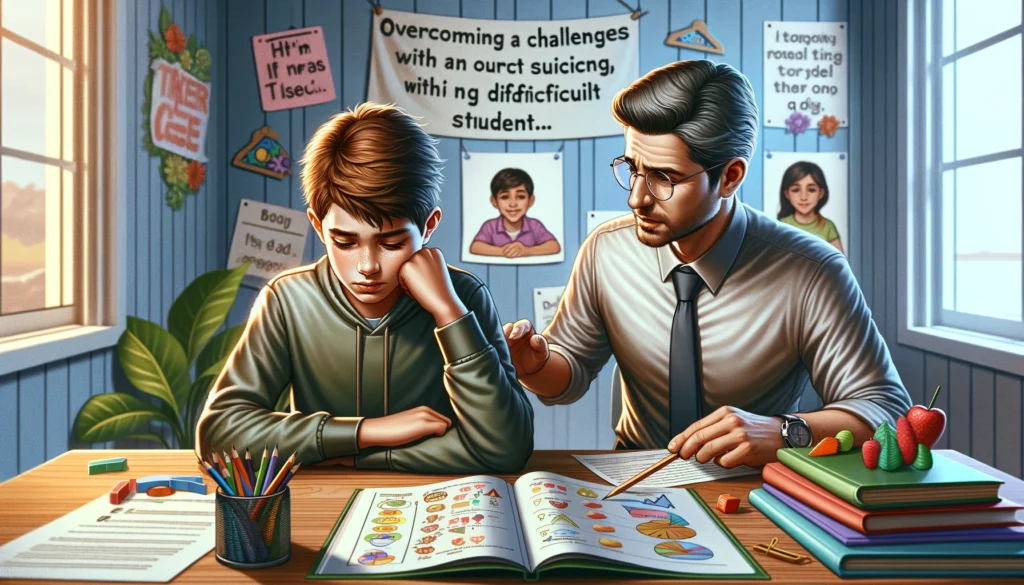I’m going to show you our tips for handling difficult students during tutoring sessions. And starting with tackling some tough questions head-on. You want to know if it can be tough to be a tutor, especially with challenging students? Absolutely, it can be. But don’t worry too much about this; I’m here to help you navigate these waters.

To set the stage, let’s consider the biggest challenge as a tutor. You’re likely to encounter a varying array of learning attitudes, with students presenting differing levels of enthusiasm and cooperation. This isn’t just about mastering the material; it’s also about understanding and adapting to each student’s unique needs and learning style.
If you’re involved in peer tutoring, you’re going to find out about its distinctive challenges. It’s one thing to grapple with conveying complex topics, but it’s entirely another to contend with the dynamics between the peer tutor and the student. Peer-to-peer interaction means there’s often less of a hierarchical structure to fall back on, which can both be a blessing and a hurdle.
So in my opinion, recognizing the demanding nature of tutoring is the first critical step. Each student brings their own set of expectations and personal challenges to the table. They might show resistance, lack engagement, or exhibit behavior that signals they’re in over their heads.
In essence, tutoring isn’t just an academic exercise; it’s a multifaceted role that intertwines pedagogy with psychology. Now, isn’t that a thought-provoking realization? As you delve further into this article, you’ll discover strategies that help you manage and overcome the complex scenarios that arise. That’s going to include fostering a growth mindset in students who ‘block’ their own progress, through to reigniting the curiosity of those who seem perpetually confused.
Strategies for Handling Difficult Tutoring Situations
Handling a student who’s hit a wall, who believes ‘It’s beyond me’ or ‘I’ll never get it,’ isn’t just about providing information; it’s about changing their mindset. Start by acknowledging what they do know to bolster their confidence. Then, carefully build from there, with encouraging feedback that celebrates each small victory.

When a student is lost in confusion, feeling overwhelmed by the course, it’s my job to bring some order to the chaos. First, I like to give their study methods some structure, helping them organize their notes and tasks. Clear, incremental goals can turn ‘I don’t know what to do’ into ‘I know the next step.’
Have you ever seen a student brimming with enthusiasm but not quite zeroing in on the task at hand? They might be seeking a miracle – hoping for vast improvement with minimal effort. Here, the key is to redirect their energy. Keep them engaged with direct questions and explain why active participation is crucial for their progress.
Then there are those who seem to have built a wall against learning, exhibiting boredom or even hostility. If you encounter resistance, give the student some space to express their feelings — to an extent. Building rapport in the first session is crucial. I’m there to help, but it’s also important to establish credibility, so they know that progress is not just possible, it’s expected.
And what about the student who just doesn’t seem interested, who’s going through the motions without engaging? Here, my strategy is to be both understanding and motivating. By asking probing questions and posing interesting problems, I try to spark their curiosity. Every bit of effort they show gets acknowledged, reinforcing their involvement in the learning process.
Keeping Students Engaged and Handling Evasion
I’m going to show you how to keep that spark of interest alive in your students throughout a tutoring session. Engagement is the name of the game, and it can make all the difference between a successful lesson and a forgettable one. You want your students leaving each session feeling invigorated, not just with new knowledge, but with the excitement of having been an active participant in their own learning journey.

Sometimes, students fall into what we call ‘evasion‘ – it’s a tricky little maneuver where they might compliment your tutoring ability or deflect with generalities to avoid diving into the lesson. I see evasion as a sign: maybe the student isn’t seeing the relevance, or perhaps they’re feeling overwhelmed. What’s my move? I get them back on track by directing the conversation to specific tasks and asking probing questions that require them to think and engage with the material.
This isn’t just about avoiding pitfalls; it’s also about seizing opportunities. Let’s talk about setting expectations and realities. Students often come in hoping for miracles—like understanding complex concepts in the blink of an eye. I want you to be the tutor that gently brings them back down to earth, helping them understand that learning is a journey that we’ll embark on together, step by step.
You can always adjust your approach down the road, but start by involving your students in setting goals for their sessions. Make them part of the decision-making process. When they feel ownership over their learning, they’re more likely to stay engaged and less likely to slip into evasion. And remember, reinforce their successes, however small. Those victories add up and keep the motivation engine running.
As you transition towards concluding a tutoring session, the way you handle these challenges can set the stage for future success. Choose strategies that resonate with you, and you’ll find it becomes easier to navigate these hurdles. That’s how you foster a learning environment where students thrive and evasion gives way to curiosity and active participation.
Achieving Successful Tutoring Outcomes
So, you’ve navigated the tricky waters of tutoring difficult students. You’ve established strategies for engagement and tackled varying behaviors. But why stop there? Let’s focus on ensuring those strategies culminate in a successful tutoring session.

First, remember that the structure is your friend. Beginning with a clear agenda sets the tone for both tutor and student. Keep your goals S.M.A.R.T. \’Specific, Measurable, Achievable, Relevant, Time-bound\’ to provide a framework for progress. This approach keeps both you and your student on track and moving forward.
Developing rapport is crucial. It’s not just a warm-up act; it’s the foundation that can turn a tough session around. Students often respond well when they feel understood and valued, so make it a priority to build a connection from the start.
It’s also about reflection. After each session, take a moment to assess what worked and what didn’t. Ask for feedback from your student. This isn’t just a one-and-done deal. Your first attempt doesn’t need to be your last, and there’s always room for improvement.
Let’s not forget about follow-up. Set the next session’s objectives or give your student actionable steps to take on their own. It signifies that you’re invested in their ongoing success, not just the time they spend with you.
There You Have Our Tips For Handling Difficult Students During Tutoring Sessions
If you can nail these elements, you’ll likely see a shift, not only in your students’ performance but in their attitude towards learning and tutoring as a whole. And while it can be hard as a tutor, especially with challenging students, remember the profound impact you can have.






